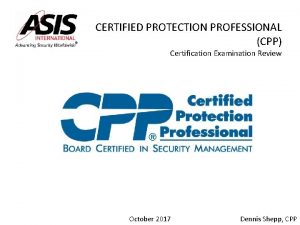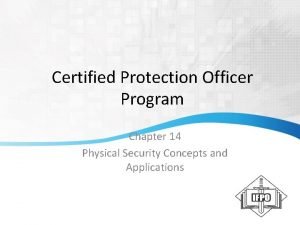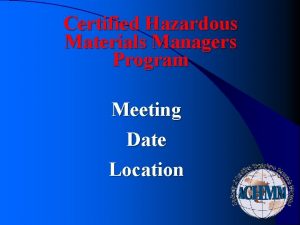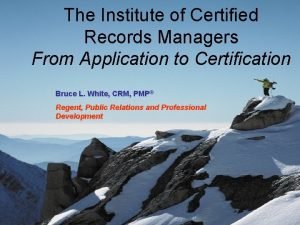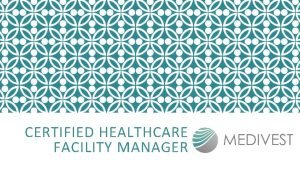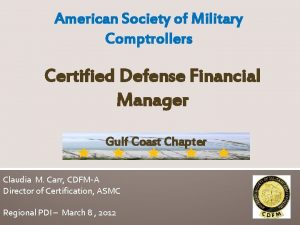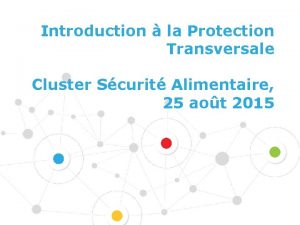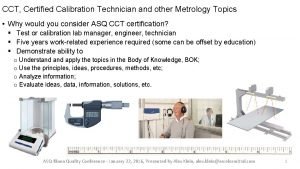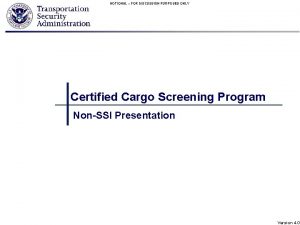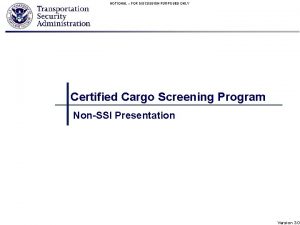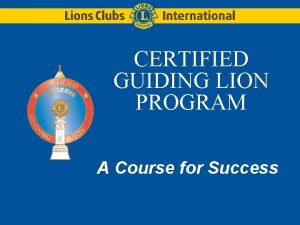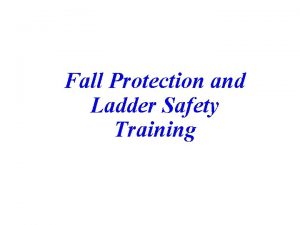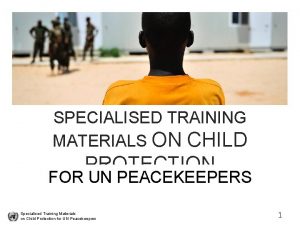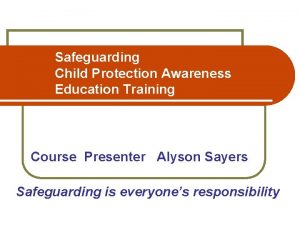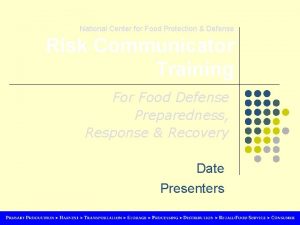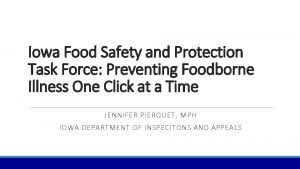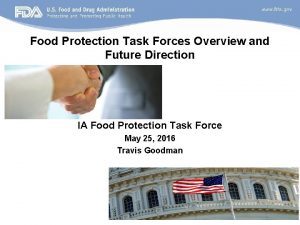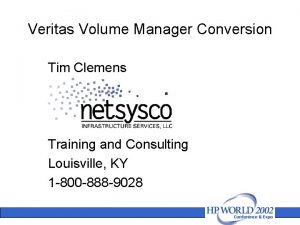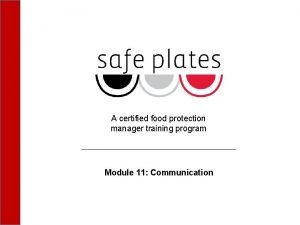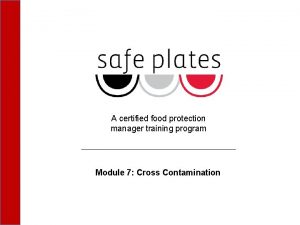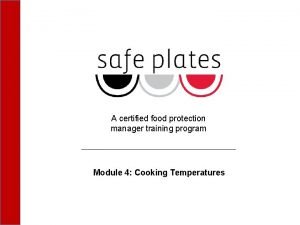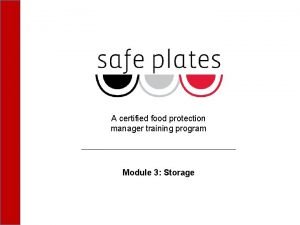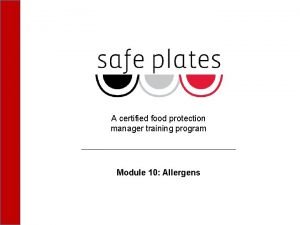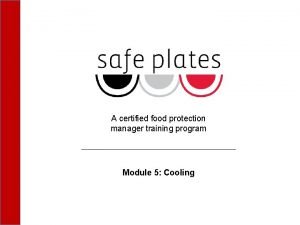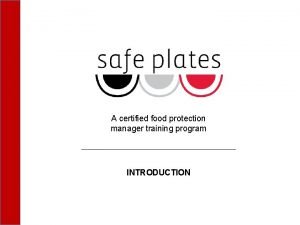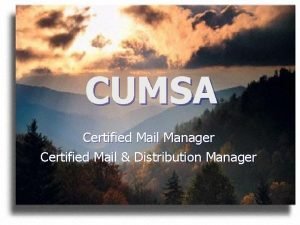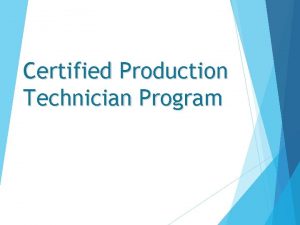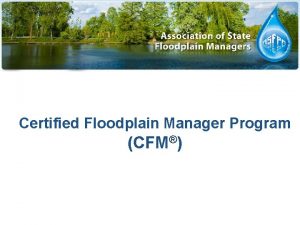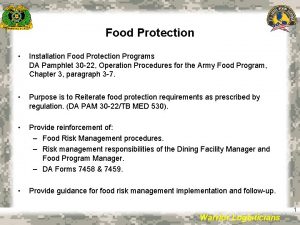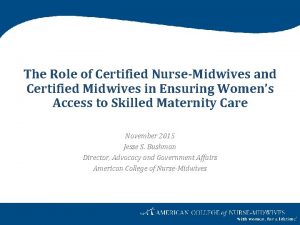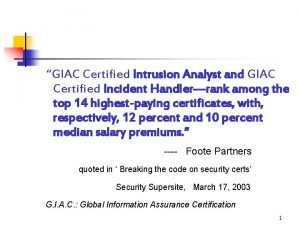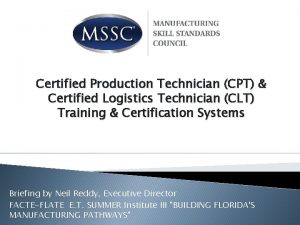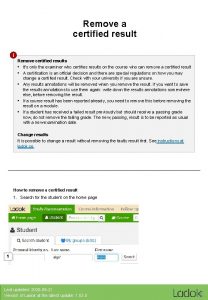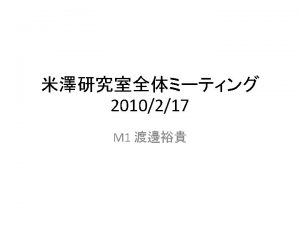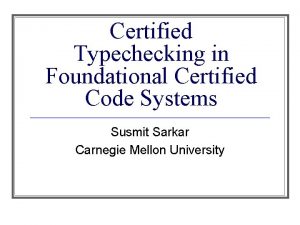A certified food protection manager training program Module

































- Slides: 33

A certified food protection manager training program Module 8: Facility Design



DISCUSSION

Learning Objectives • Describe symptoms, sources, and control for Cryptosporidium, Giardia, Toxoplasma, Anisakis and Trichinosis • Explain how sanitary facilities and equipment impact food safety • Identify methods to reduce cross-contamination in flow of food

Key Terms • Parasites – microorganism that lives in or on its host and feeds at the host's expense • Back flow – a reverse flow of contaminated water into potable water • Air gap – an open space separating water from drain systems that prevents back flow

Cryptosporidium – A Parasite • Infects cells of the intestines. Infected people shed more eggs in their feces • Can be spread by contaminated water and feces • Most common on produce and fruits irrigated with contaminated water • Causes severe diarrhea, abdominal cramps, mild fever and nausea within 7 days

Giardia • Found in improperly treated water, also infected people and their feces • Can be spread by food, water, and person to person • Causes fever, diarrhea, cramps, nausea (especially bad smelling gas and diarrhea) • Onset in one week or longer

Toxoplasma Gondii • Causes Toxoplasmosis • More than 60 million people may be infected • Few have symptoms (asymptomatic), immune system prevents illness • Pregnant and immunocompromised could have serious illness • Infection through: – contaminated water or soil – fruits and vegetables – contact with cat feces (cleaning litter box)

Anisakis Simplex • Wormlike parasite found in certain fish and shellfish. • Symptoms: – Tingling in throat, coughing up worms – Stomach pain, vomiting, diarrhea – Can infect the stomach and intestines; must be surgically removed • Cook properly to kill parasites • Purchase sushi grade fish (previously frozen). Freezing will kill this parasite. • Onset 4 -6 hours, sometimes up to 7 days

Trichina Spiralis • • Causes Trichinosis Present in pork and wild game (bear) Problem when pigs fed garbage Symptoms: – nausea, abdominal pain, vomiting, diarrhea – muscle pain, fever, breathing difficulty – average symptom onset, 2 -28 days • Control: – proper cooking 145 o. F for 15 sec.

Controlling Parasites • • • Safe water supply and plumbing Products from approved suppliers Cook meats (whole cuts) to 145 o. F. Cook poultry to 165 o. F Use good personal hygiene Clean and sanitize equipment, utensils, etc. Avoid cross-contamination

Water • Safe water sources • Drinking water quality – Control chemicals and pathogens – Use public water system OR – Test nonpublic water system – Contact local regulators for details • Sufficient volume and pressure to meet peak use, including hot water • Remember the ice machine!

Plumbing • Drainage (sloped to drain, grease traps) • Sinks: – Back flow prevention – Anti-syphon, vacuum break • 1” air gap for drains • Know sewage infrastructure, septic vs sewer – Avoid cross plumbing – Flush after work is done • Only hire professionals, ask questions

Lighting Requirements • Proper lighting – 10 foot-candles at 30 inches in storage – 20 foot-candles for hand dish washing, equipment storage – 50 foot-candles for work areas • Shatter resistant and/or shielded bulbs

Vents and Electricity • Locate to minimize interference with cleaning • Minimize exposure of electric wiring and panels • Vents constructed to avoid potential contamination • Able to minimize excessive heat, steam, smoke

Sanitary Facilities and Equipment • Food preparation, display, and service areas must be cleaned regularly to maintain the facility in a sanitary condition. • Should be easy to clean and sanitize • Flooring is non-permeable, slip resistant, proper coving • Cleaning around large equipment, mobile is ideal

Ideal Construction Materials • • • Durable Impervious Smooth without cracks or seams Light color Easy to clean Heat resistant

Other Design Considerations • Map flow of food • Separate prep and separate storage • Dedicated equipment • Communication among workers

Flow of Food • The path food follows from storage to plating/service is important. • Flow should generally move from raw to service • Minimize chances that potentially contaminated ingredients, surfaces, and utensils contact prepared foods.


Separate Prep and Storage Areas • Physical distance is important – Cold and hot prep areas – Food washing, hand washing, dirty dishes… – Remember Module 3: Firefly and Salmonella • Arrange to minimize risk. Separate sections or coolers if possible. • If prep space is limited, minimize risk by timing of prep activities – Ex: cold prep, clean and sanitize, hot prep

Dedicated Equipment • Assign specific equipment for each type of food if possible • Color code to prevent mix-ups. • Employee communication is key Remember to clean and sanitize as needed

Communicate - Do the Right Thing • Employees need to communicate with each other to prevent cross-contamination • Comfortable speaking up if they see a risky situation or activity • Follow through to correct the problem Remember when we talked about food safety culture?

Buying, Building, Remodeling • Contact local health department • Review plans: – Appropriate design – Meet all requirements • Communicate with contractors • Clean before use

Case Study What Happened What Went Wrong 1993 Milwaukee, WI, ½ the population infected with a parasite Largest parasite outbreak in US history Water system contaminated with Cryptosporidium Shut down the city’s water system

Case Study What About Restaurants? Could happen on a small scale in restaurants Proper plumbing work Safe water supply Prevention • Proper plumbing • Flush restaurant water lines • Remember the ice machine • Exclude sick employees

Discussion The work environment plays an important role in food safety. How can managers influence the following to minimize food safety risks? • Condition of work areas • Flow of food, including cleaning and sanitizing • Employee work behaviors

Quiz The best procedure to reduce Anisakis in sushi products is: a) b) c) d) cook to 130 o. F store in cooler at 41 o. F for 1 week freeze product place in chlorine solution

Quiz The best procedure to reduce Anisakis in sushi products is: a) b) c) d) cook to 130 o. F store in cooler at 41 o. F for 1 week freeze product place in chlorine solution

Quiz The correct light in foot candles for a food preparation area is: a) b) c) d) 20 50 10 60

Quiz The correct light in foot candles for a food preparation area is: a) b) c) d) 20 50 10 60

Review • Cryptosporidium, Giardia, Toxoplasma, Anisakis, Trichina • Sanitary facilities and equipment – Plumbing, lighting, electric, and vents – Equipment and work areas • Flow of food
 Certified protection professional cpp
Certified protection professional cpp International foundation for protection officers
International foundation for protection officers Certified protection officer
Certified protection officer Exhibition management course
Exhibition management course Isachmm
Isachmm Certified records manager certification
Certified records manager certification Certified healthcare facility manager
Certified healthcare facility manager Cdfm certification
Cdfm certification Module sur la protection transversale
Module sur la protection transversale Vrf code
Vrf code Asq cct
Asq cct Certified training professional
Certified training professional Pella certified contractors
Pella certified contractors Tsa certified cargo screening program
Tsa certified cargo screening program For discussion purposes only
For discussion purposes only Certified guiding lion test
Certified guiding lion test Senior manager vs general manager
Senior manager vs general manager Portfolio manager synergy manager parental developer
Portfolio manager synergy manager parental developer Unit 2 food food food
Unit 2 food food food Sequence of food chain
Sequence of food chain C device module module 1
C device module module 1 Types of scaffolding ppt
Types of scaffolding ppt Fall protection training outline
Fall protection training outline Child protection training materials
Child protection training materials Child protection awareness training
Child protection awareness training National center for food protection and defense
National center for food protection and defense Iowa food protection task force
Iowa food protection task force Iowa food protection task force
Iowa food protection task force Primerica legal protection program
Primerica legal protection program Community air protection program
Community air protection program Witness protection program philippines
Witness protection program philippines Veritas volume manager tutorial
Veritas volume manager tutorial Notam manager
Notam manager Ucla npear
Ucla npear
